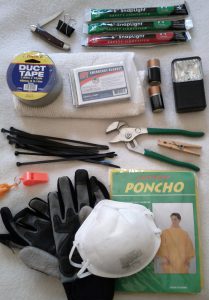1. DO YOUR RESEARCH:
The Florida Emergency Preparedness Guide can be found at http://www.floridahealth.gov/programs-and-services/emergency-preparedness-and-response/_documents/prepareguide-eng.pdf and The Essential Guide to Hurricane Preparedness can be found at http://www.floridahealth.gov/programs-and-services/emergency-preparedness-and-response/_documents/prepareguide-eng.pdf . More resources can be found by visiting Florida’s Division of Consumer Affairs website https://www.myfloridacfo.com/Division/consumers/Storm/default.htm

2. COMPOSE A CONTACT LIST:
Consumers change phone carriers from time to time and do not always retain their old numbers, so take care to update phone numbers. Include in your list, contact information for at least one out-of-state friend or relative. Add contact information for your insurance carrier. Obtain a list of local emergency numbers. Post all these numbers in a prominent place in your home and also by landline phones. Remember to save updated numbers in your mobile devises. Contact your UF/IFAS Extension Service for a complete listing of local agencies tasked with resident support during periods of severe weather and recovery efforts. Teach/ inform youth how and when to call 911.
3. CREATE A HOME INVENTORY:
Record your possessions using photographs, videos, or inventory software. Remember to back up your photos at a second location even if they are saved on your mobile devices. Store a copy locally and mail a sealed copy to your out-of-state contact for safe keeping.
4 REVIEW YOUR INSURANCE COVERAGE:
Read through your policies carefully to be sure you have a full understanding of your coverage. Are you insured for actual cash value, replacement costs, windstorm, storm surge, flood, sinkhole, hurricanes? Research roof bracing and strengthening, window and door coverings. If you have any questions at all about your coverage, don’t wait until there is a named storm. Now is the ideal time to call your agent with any questions or concerns.

5. ASSEMBLE AN EMERGENCY SUPPLY KIT:
Prepare an emergency supply kit. Include water, non-perishable foods, first aid kit, prescription medications, weather radio, batteries, baby wipes, and ‘busy activities’. Visit FEMA for a more comprehensive list. https://www.fema.gov/media-library-data/1390846764394-dc08e309debe561d866b05ac84daf1ee/checklist_2014.pdf
6. DESIGNATE A SAFE PLACE:
Identify the safest room or area in your home or on your property to ride out the most treacherous period of the storm.
7. CONDUCT A MEETING:
Hold an informal meeting with everyone included and affected by your household’s storm plan. Seek advice from individuals with storm experience. Make modifications to the list below according to your discussions.
8. GET CASH: Get cash early. ATM’s fail with power outages and if a storm is imminent, it is likely financial institutions will close early or not open at all.
9. FUEL UP: Gasoline and diesel pumps fail with power outages and/or shortages can occur suddenly. In anticipation that this could happen, when possible keep your tanks topped-up.

10. BATTEN DOWN YOUR HATCHES AND IDENTIFY YOUR ‘MISSILES’: Have you devised a method of securing your home’s most vulnerable features? Inspect all your windows, doors, including garage doors. Designate a place to stow your outdoor furniture, plants, stones, bricks, etc.

11. SECURE ANIMALS: Develop a plan for your pets and/or farm animals. To learn about a pet plan visit https://www.floridadisaster.org/planprepare/pet-plan/ . To learn more about disaster preparedness with animals, visit https://hospitals.vetmed.ufl.edu/2017/09/06/disaster-preparedness-with-animals/ .For more information about your specific area, contact your local UF/IFAS Extension office. For information about Florida locations, visit http://sfyl.ifas.ufl.edu/find-your-local-office/
12. EVACUATE: Consider what factors will influence your determination to stay or go. When planning your escape routes, take flooding, road closures and traffic jams into consideration.
13. SELECT A MEETING PLACE: Consider individuals who may be away from home, if a sudden event (such a downed lines or flooding) takes place. Make provisions for pick up at a pre-determined location. Pre-select locations to meet within one mile, within twenty five miles.
14. REHEARSE: Kinks can get worked out with preplanning and dry runs.

15. REVIEW, UPDATE: May 1st (May Day) is an easy date to remember to update your storm plan. Obtain current shelter information. Check for changes in out-of-state contact information. Date your updated plan and mail your out-of-state contact the updated version of your plan. Refresh food, water, and medication supplies.
#Tropical Storm Michael
#Hurricane Michael
 0
0
